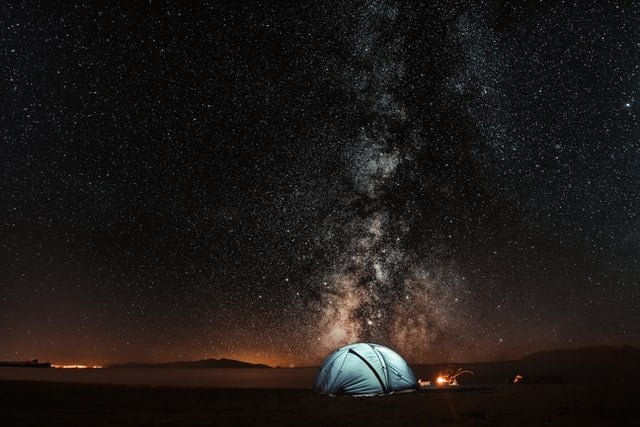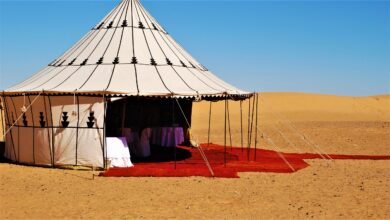How to stay warm for camping in a tent

How to stay warm for camping in a tent
Tent camping is a great way to enjoy the great outdoors – but it comes with its own set of challenges.
In addition to a potential lack of comfort (check out our top tips for making tent camping more comfortable to solve this problem), you’re at the mercy of the weather, especially the cold.
Of course, staying warm during winter camping is challenging. But, cold can also be a major factor even when camping in summer, especially in the desert, mountains and other areas known for cool nighttime temperatures.
Fortunately, staying at a warm camp in a tent is not difficult with some preparation, a little knowledge, and the right equipment.
Here’s exactly how to stay warm camping in a tent on cold nights.
Preparation is the key
With the right equipment, you can go camping in almost any weather conditions.
But, it is still always necessary to keep an eye on the expectations, so that you know what you are getting into yourself.
Read about the weather before you head out so you know exactly what gear to pack and what to expect at your camp site.
This is especially important if you are planning to travel in a meltdown country.
Check your camping checklist (or backpacking checklist) and double-check to make sure you have all the gear you need. You don’t want to be stuck camping in cold weather without the right winter camping gear.
Speaking of your camp site, choosing the right one goes a long way toward staying warm while camping in the winter.
If possible, choose a camping site with natural wind mass. But, at the same time, make sure you’re not camping under dead branches (known as widow makers), especially if there’s snow.
Ideally, you’ll also avoid valleys and other natural depressions in the terrain. Cold air is usually trapped in these lower areas. Instead, find a camping site at a normal altitude (not completely exposed).
Finally, always remember to let someone know where you are camping and what your plan is while you are there.
Sure, this won’t help you stay warm while camping in the tent, but it’s very important for your overall safety. Do this always, no matter what time of year or forecast weather.
Get the right tent
Winter camping tent is a must when camping in cold and snowy conditions.
Look for a 4-season tent designed to stand up to harsh weather. They are usually heavier and stronger than your standard three-season tent due to the reinforced poles and stronger materials.
Although a 4-season tent is a good option for snow camping, most winter campers should be able to get away with a typical 3-season tent.
The exceptions are if you are camping above a tree line or other open area or are expecting heavy snow or strong winds. The 4 season winter tent will be better off in strong wind than the 3 season model.
If you choose a 3-season tent, make sure it has a full-coverage rain cover and a dome shape for rain and snowfall.
Personally, here in the Pacific Northwest, I’m always fine with a 3-season tent because I camp in fairly mild, if cold, conditions.
Cabela’s Alaskan Guide Tent is a great winter tent. Although it’s a 4 season tent, it performs well in spring, fall, and even summer thanks to a removable rain fly and amazing ventilation.
Another option for winter camping is a canvas tent. Although much more expensive than a traditional nylon tent, winter canvas tents withstand snow and wind better. Plus, they really do provide some insulation and are able to trap warmth (which a regular tent can’t really do).
Even better, you can use a winter tent stove inside most canvas tents. Don’t get too far ahead of heating your tent with a crackling fire when it cools down outside.
Check out our guides to the best winter tents, best camping tents, and best family tents for more information on how to choose the best tent for your trip.
A warm sleeping bag is a must
Even more important than a high quality winter tent is a warm cold weather sleeping bag.
In fact, a high-quality sleeping bag, properly rated for the temperature you’d expect, is the best way to camp in a warm tent.
Our guide to the best winter camping sleeping bags explains exactly what to look for in a winter bag (and offers a set of recommendations).
Most important is to look at the minimum temperature rating. This number is the lowest temperature the manufacturer believes the average user will stay warm.
Personally, I always find it best to choose a sleeping bag with a temperature of at least 10°F to 15°F below the coldest temperatures you expect to experience.
In fact, on my winter camping trips, I usually choose something warmer than this. You definitely don’t want to be stuck with a sleeping bag that isn’t warm enough on a cold night. If you’re too warm, just unzip the bag to get a little ventilation.
In terms of design, the mummy bag is a much better choice than the rectangular bag on cold nights thanks to its superior insulating properties.
For extra warmth, consider adding a sleeping bag liner. Not only does this help keep your bag clean and extend its life, but it can also add a great deal of warmth. Most liners add about 10 degrees Fahrenheit to the sleeping bag’s temperature rating.
Don’t forget the sleeping pads!
Sleeping pillows (see our full sleeping pillow guide here) aren’t just about comfort.
They also add a lot of warmth to your camping sleep setting by better insulating you from the cold ground.
A closed-cell foam sleeping pillow always provides better insulation than an inflatable air pillow, although some airbags are insulated.
If you usually use an inflatable sleeping pillow while camping, I recommend pairing it with a closed cell winter camping foam pillow.
Simply use the air cushion on top of the foam cushion for a bundle of insulation and comfort.
When I’m camping in cold weather, I often bring several sleeping foam pillows for extra insulation. The better the ground insulation, the warmer it will stay.
A crib is another option. At the same time it helps keep you off the cold ground, it also allows cold air to circulate beneath you.
When camping with a crib in the winter, I highly recommend a closed-cell foam sleeping pillow, or a high-density foam pillow for better insulation.
The same goes for a camping hammock. Yes, hammock camping in winter is totally possible. But to avoid cold syndrome, you need to add an insulating material in the form of a sleeping pillow and a quilt.
A big part of staying warm while camping in tents comes down to getting insulation under you, between your body and the ground, regardless of your camping sleep setting.
Consider insulating your tent
It is possible, albeit somewhat difficult, to insulate a tent for cold weather camping.
First things first, clear the floor of snow if possible. Your tent will retain more heat if it is placed directly on the ground rather than on ice.
Next, bring some kind of ground cloth. The tent space that comes with your tent is fine, but adding a tarp is even better. Just make sure the tent does not go beyond the bottoms of the tent as this can create a ship of snow and rain to sit in.
Remember that small tents are easier to insulate. The smaller your winter tent, the better.
Fill the tent from the inside with additional floor insulation. Closed-cell foam sleep pillows are a must. But you can also put in blankets, rugs, or even a foam pad such as yoga mats to completely insulate the floor.
Now, to the outside of the tent. The best winter tents have full coverage of rain flies. Not only does it rain and snow, but also slightly improves insulation.
If you are expecting wind, make some kind of windbreak. Trees or car running. In deep snow, you can also build a snow wall to protect your tent from the wind.
To actually insulate a tent, you can add layers of thermal blankets or other insulating fabric to the interior walls and ceiling. Duct tape inflates to connect thermal blankets to the inside of your tent.
Of course, this extra insulation will affect ventilation, but it can make a noticeable difference in overall warmth by trapping your body heat inside the tent at night.
One last tip for tent insulation is to put all of your extra gear around the edges of your tent. Put extra clothing, backpacks, etc. around the perimeter of your tent to increase insulation.
While tent insulation is possible, it is usually easiest to insulate yourself.
A properly rated sleeping bag (as noted above) with a sleeping pillow is essential. Warm clothing (described below) is also essential.
For maximum tent insulation, I would again recommend a canvas tent. The naturally thicker fabric has better insulation properties than the best nylon winter tents.
Pack warm clothes
Layering is important when camping in the winter.
Wear a lightweight long-sleeved base layer that is close to your skin without being too restrictive. Be sure to choose a material that is breathable and moisture-wicking. Polyester or nylon is a good choice.
The next layer should be a warm medium layer. Wool or polyester is best. Think wool pants and a fleece top zip. Remember that this is the insulating layer and it should be much warmer.
Next is the outer layer. This outer layer of winter clothing should consist of a waterproof but breathable jacket and waterproof and breathable pants. This is the layer that sheds any rain, snow or wind to keep the inner layers warm and dry.
The idea behind layers is that you can add or remove layers as necessary. You never want to get too hot while camping in the winter. And if you do, you want the sweat to be wicked away from your body where it can dry quickly.
Personally, I like to bring a separate base layer to wear at night in my tent.
Chances are you’ll break a sweat prep or complete camp errands before bedtime. You don’t want to go to bed with damp or damp clothes. This can lead to frostbite, hypothermia, and other serious problems.
A dry base layer that is tight but not too tight and made of synthetic fabrics or wool will greatly help you stay warm while camping in a tent.
Personally, I like to wear thin gloves, warm fleece socks, and a beanie at night. Add or remove them as needed overnight.
Cotton is usually a poor choice for winter camping (and frankly, camping in general) since it’s not very breathable and doesn’t wick away sweat.
Our winter camping gear guide has more advice on choosing the right winter clothing for your next cold-weather camping trip.
Of course, a pair of durable, well-insulated, waterproof winter hiking boots with good traction is also essential for winter camping.
Handy portable tent heater
I am a big fan of using a portable tent heater when camping in the winter.
The portable heater is hugely useful for keeping warm during cold weather excursions, especially when it’s cold at night.
Although some people turn tent heaters on at night inside their tents, personally I prefer to only turn tent heaters on when I am awake.
I use my tent heater to warm the tent before bed and right when I wake up. Make sure there is proper ventilation if you are using the propane form.
Just know that even with a heater in the tent, your tent is unlikely to retain heat for long. Unless you have a very insulated tent, a heater is only capable of providing heat during use.
Personally, I prefer propane heaters for winter camping. Mr. Heater is the gold standard in my opinion. I like Mr. Heater Little Buddy better than their offer of tent camping.
But it is also possible to use an electric tent heater. Pair a portable electric heater with a portable power station for camping use. You can even use a portable solar panel to charge the portable power station on long trips.
Our comprehensive guide to the best portable camping heaters will help you find the perfect model for you.
Another option is a tent stove. However, these portable wood stoves are only compatible with certain tents – so check yours before investing.
Although not currently for sale, Big Horn III Cabela’s is an excellent example of the type of winter camping tent I’m talking about here. It can be used safely with a variety of tent stoves, including Four Dog Stoves.
Other tips for staying warm in a tent
There are quite a few other things you can do to stay warm while camping in a tent.
This includes sleeping close together, using a hot water bottle at night, eating a high-calorie bedtime snack, and warming up before getting into your sleeping bag.
Equally important, don’t pack them inside your sleeping bag too far. You don’t want to breathe in your bag which causes the vapor to condense and will eventually make you cooler than before.
Additional Winter Camping Tips
Learning how winter camping is about more than just staying warm. Here are some additional tips to get the most out of it.
Remember to always bring a shovel when camping in the snow. This will allow you to more easily clean the ground for your tent, build a windmill from snow, and many other tasks.
I also like to bring a sled. If you’re not able to camp right next to your car, a sleigh makes transporting equipment to your camp site a lot easier, especially if you’re packing in a heavy canvas tent and wood stove.
Snowshoes or cross-country skis make getting into a winter camp much easier than hiking.
To stay safe during winter camping, know the signs of frostbite and hypothermia. Read about avalanche safety so you can avoid avalanche-prone areas.
Remember to check the tent all night in high winds. You will probably want to check the tent poles and rigging at least every two hours to make sure they are holding up.
The same goes for checking the walls of the tent. Press it overnight if it is snowing to prevent snowfall.
Our ultimate winter camping and winter backpacking guide contains more tips, tricks, and tips.
what about you?
Staying in a warm camp in a tent is frankly very easy with the right equipment.
In fact, I’m a big fan of taking camping trips in cold weather because the winter environment is so beautiful and you’ll likely have the whole forest to yourself.
what about you? How often do you go for winter camping? Do you have extra tents on how to stay warm in a tent?



